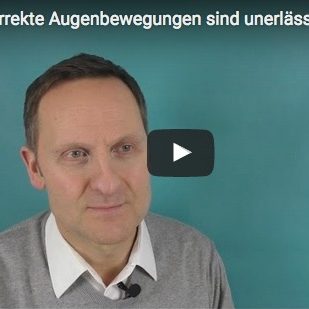EMDR is the abbreviation for Eye Movement Desensitization and Reprocessing and was discovered accidentally in 1987 by the US psychologist Francine Shapiro. Since then, the method has been used successfully worldwide. This involves the application of several steps, which are ordered in a clear procedure:
The eight phases of the EMDR protocol

A complete EMDR process of an EMDR treatment consists of eight EMDR phases, which can be modified accordingly in the case of complex traumatic disorder patterns, such as extreme neglect, physical abuse or sexual abuse.
In order to be able to treat the entire clinical picture identified in the diagnostic phase, various techniques are used in the structured working through of the eight EMDR phases of the EMDR process.
 Thus, following an anamnesis as well as a stabilization phase and the assessment phase, in the processing phases first the triggering memories of the past, then still currently existing triggers, and finally remaining negative ideas about the client’s future are focused on and processed. Treatment with EMDR – Eye Movement Desensitization and Reprocessing can lead to significant improvement of the emotional situation in some situations after only four to five sessions.
Thus, following an anamnesis as well as a stabilization phase and the assessment phase, in the processing phases first the triggering memories of the past, then still currently existing triggers, and finally remaining negative ideas about the client’s future are focused on and processed. Treatment with EMDR – Eye Movement Desensitization and Reprocessing can lead to significant improvement of the emotional situation in some situations after only four to five sessions.
A therapy session usually lasts between 50 and 60 minutes. Depending on the needs and planning of a treatment session, another session can follow immediately in order to adapt the treatment to the scope of the topic and to be able to complete the EMDR process in one go.
Note on EMDR self-coaching
Please note: The EMDR self-coaching method and its 6 steps, which can be used perfectly with everyday sensitivities and emotional stresses of a healthy person, was derived from the EMDR process. In EMDR self-coaching, some phases have been omitted, and other phases have been slightly modified or changed in their order to simplify the EMDR self-coaching process.
This has not limited the effectiveness of the EMDR method. However, EMDR self-coaching, a special form of EMDR coaching, is not suitable for treating conditions such as trauma or post-traumatic stress disorder (PTSD).
Therefore, please always distinguish between coaching and self-coaching as well as therapy. Illnesses are treated with EMDR exclusively by an experienced EMDR and trauma therapist as part of therapy. Please also read the important information.
Overview of the 8 phases of the EMDR protocol:
- Anamnesis and treatment planning
- Stabilization and preparation
- Assessment/evaluation before processing
- Processing (EMDR process)
- Anchoring
- Body test
- Conclusion
- Review and reassessment
Phase 1 – Medical history and treatment planning
As with any other form of therapy, this initial treatment phase serves to establish a trusting therapeutic relationship, combined with an assessment of whether the person to be treated is sufficiently stable mentally and physically to cope with the intense emotions that may arise during treatment (abreaction). Then, a treatment plan for a sequence of sessions is determined together with the client as part of the EMDR guidance.
If, in connection with the first phase of EMDR treatment, the therapist has doubts as to whether the client is able to bear the possibly painful memories and the associated emotional feelings, this may possibly be an indication for a corresponding extension of the stabilization phase or a differential indication (inpatient treatment). It is also important to consider the current life contexts and expectations of the EMDR intervention.
Specific guidelines should be considered for dissociative identity disorders as well as anamnestic relevant dissociative disorders. This includes, for example, agreeing with the client which event should be processed first during EMDR. This phase is also about working out what is dysfunctional in information processing.
In addition, resources are requested in the first phase. In particular, the resources that the patient has used so far to be able to live with the trauma. Frequently, this reveals behaviors that show pathological behavior, but which have developed out of an initial survival strategy after the traumatizing event.
During the trauma history that follows, the EMDR therapist builds a picture of the client’s experiential experiences that are believed to have triggered the trauma. Here it is important to proceed cautiously and to inquire about the events exclusively by means of targeted factual questions in order to create a simple list and without confronting the client too intensively with emotional memories. If the client is confronted with the trauma too early and without prior stabilization, this can lead to retraumatization.
Phase 2 – Stabilization and preparation
The client is offered explanations of how EMDR – Eye Movement Desensitization and Reprocessing works. Here, reference is often made to the processing of unconscious material in the REM phase during dreaming. Mutual expectations as well as roles are clarified. Distancing and relaxation techniques (especially“safe place“) are established in order to be able to stabilize the client at any time during the EMDR treatment if necessary.
The second phase is for the client and EMDR therapist to gain a common trusting foundation. This involves explaining what the client and therapist expect from the sessions. It is also extremely important for working with EMDR that the client is able to relax and distance themselves from the issue. Often it is here that special attention and work is needed. Thus, a safe place should always be established with the client.
Note on EMDR self-coaching
At the EMDR self-coaching, the establishment of the Safe Place is not one of the 6 steps, as it is assumed that the user is able to move from the coaching topic at any time and to be able to calm yourself down. But even if there is no compelling need for self-coaching, setting up a Safe Place and traveling there repeatedly is always an enriching, calming and beautiful experience. A Safe Place is therefore highly recommended.
Waving the therapist in front of the client’s eyes is “practiced” at this stage. Preferably, this should be done in a positive context to positively anchor visual stimulation via the eyes. This is to avoid a traumatized client developing a fear of the method and waving. In addition, the client and therapist agree on a stop and continue signal to stop or even prolong bilateral stimulation by the therapist, who usually decides on the duration of a stimulation set, if needed.
During the stabilization phase (second phase of the EMDR protocol), the goal is to establish the client’s affect regulation. He should be able to calm and comfort himself afterwards. This is an important prerequisite for being able to approach the trauma emotionally during EMDR treatment without being helplessly at its mercy.
Phase 3 – Evaluation
This phase of EMDR is for assessment.
Before processing can begin using rapid eye movements, the EMDR therapist asks the client to recall his or her subject. The process of assessment consists of several sub-steps (other methods that have adopted the EMDR process but also EMDR self-coaching title these sub-steps with a separate step or phase).
- Focusing on the stressful issue (initial situation) in the form of a sensory reminder
- Distressing negative cognition (NK) ” When you think of the baseline situation, what do you think of?
- Positive Cognition (PK): “What would you rather think?”
- Assessment of the PF on the VoC scale (credibility) from 1 = completely wrong to 7 = completely true
- Naming the distressing emotions and estimating the degree of distress(SUD scale) from 0 = neutral to 10 = worst state.
- Description of body sensations and localization in one’s own body
After all partial steps have been carried out, the EMDR process, the 4th phase directly follows.
By asking the subjective units of disturbance (SUD) according to the treatment protocol, related to a scale between 0 and 10 (0 = no disturbance at all, 10 = the most imaginable disturbance), the current state of well-being is assessed.
Before the desensitization phase begins, a safe place is agreed with the client or a person with whom the affected person feels safe and absolutely secure.
Phase 4 – Desensitization phase – Reprocessing through processing (EMDR process).
In this fourth phase (the actual EMDR process), the traumatic memory is processed with the eye movements (set of 20 to 30 eye movements each) until the subjective stress level has dropped significantly.
Here, the therapist uses rhythmic external stimuli, typically in the form of rapid horizontal finger movements, which the client has to follow with his eyes (“rapid eye movement“), while at the same time focusing on the previously selected stressful scene with all its emotional, cognitive and somatic components. Under these conditions of divided attention directed both to a stimulus from within (trauma-focused imagination) and from without (finger movements), an extraordinary waking state of consciousness is induced in which chains of associations from the traumatic neural network are activated in a waking dream-like state.
Read more about the correct execution of the rapid eye movements (more)
As agreed, the client can signal an immediate interruption at any time during this process by a simple hand gesture (or agreed sign). Otherwise, this EMDR process (“set”) is terminated after about half a minute to a minute. The patient is then asked to report what he has just experienced in the form of thoughts, feelings or pictures.
At this point, conversation about content or commentary by the therapist is not sought. Possible interventions only serve to promote the ongoing associative process or to clarify a process blockage. Following the rapport, the most stressful or currently foregrounded element (“worst case scenario”) is proceeded with.
The therapist aims for scores of 0 to 2 on the SUD scale during the EMDR process. After the eye movement series, the client is asked, “And now what?” or “What is now?” When changes in sensory thoughts, feelings, or impressions, as well as pictorial imagination, are reported, the therapist focuses on this new circumstance and asks the client to direct attention to the newly emerged material. The client is asked to stay withit (“Keep going with it”) while a new eye movement series is induced.
After each EMDR series, the client is allowed to take a deep breath. He is then questioned again about what has now surfaced. It is often observed that in the course of the eye movement series, either further details of the traumatization emerge via the associative memory network or there is a continuous changing and distancing of attitudes, figurative memories and feelings. Here, too, there may be an increase in arousal.
The EMDR process (processing) usually results in relief for the client and a boost in self-esteem.
Phase 5 – Anchoring
When the emotional pressure of the memory has decreased sufficiently in the course of processing (SUD value has decreased to 0 or 1), a positive cognition previously selected by the client (e.g., “I am strong enough”) is associated with the currently imagined scene. At the same time, the patient assesses the credibility and coherence of this combination (VOC = Validity of Cognition) on a scale of 1 to 7 (1 = no agreement at all, 7 = complete agreement), which is also repeatedly checked in the further course of the therapy and modified if necessary before it endures as a helpful cognitive restructuring also for the future. Using bilateral stimulation, EMDR enhances positive cognition while further attenuating negative traumatic sensations.
Note on EMDR self-coaching
In the EMDR self-coaching method and its 6 steps, self-questioning after a negative cognition is omitted, as this had regularly caused irritation among self-users. In self-application, however, no EMDR coach or, as in therapy, EMDR therapist can guide the process and offer explanation and assistance when there is uncertainty. Therefore, in the EMDR process for self-coaching, positive cognition was incorporated in the 6th step.
This approach resulted in an irritation-free self-coaching application.
Phase 6 – Body test
Here, it is checked whether even the last load residue has actually disappeared. If the coherence of the positive cognition has reached the value 7, the client should visualize the initial situation in connection with the positive self-belief. With this attention, the person concerned should slowly wander through his body and describe the bodily sensations that arise in the process.
Note on EMDR self-coaching
In the EMDR self-coaching method, the body test (Body Scan II) is done to uncover residual bodily sensations before anchoring to create an easy-to-follow process for the self-user. This modification of the standard EMDR protocol also proves beneficial in EMDR self-coaching.
Phase 7 – Closure
In order to be able to secure or establish an emotional balance, short distancing as well as relaxation exercises are offered at the end of the EMDR process. In this way, remaining elements of the trauma are also “repackaged” (vault exercise). In addition, behavioral measures for emergencies are also discussed.
Note on EMDR self-coaching
In the EMDR self-coaching method, sensitivities and stresses of everyday life are processed. Their emotional stress level before and especially during an EMDR self-coaching session must be bearable for the user. In addition, the self-user must be able to calm himself and distance himself from the subject (see Phase 2: Stabilization and Preparation). Issues that a coachee does not feel up to, may feel great insecurity about, or even fear working through an issue should be discussed with an EMDR coach or EMDR therapist (go to Thomas Buhl’s practice) and not approached through self-coaching. Read also Self-coaching or coaching with the coach – how do we decide?
After an EMDR self-coaching session, the emotional distress usually visibly subsides, if not completely dissipates. For this reason, short distancing as well as relaxation exercises were not included in the 6 steps.
Certainly, it is up to each self-user to additionally perform such exercises, as is common in therapy or in coaching after strongly involving or unfinished topics.
Phase 8 – Follow-up survey
At the beginning of the next EMDR session, a check is made to see if the initial topic from the last session has been fully processed and thus completed, or if new material has emerged. Furthermore, current triggers of the symptomatology and possible future triggers (so-called future projection) are addressed and worked on in this phase.
Sources:
Trauma therapy with EMDR – 2nd edition – Oliver Schubbe (ed.) – Vandenhoeck & Ruprecht
EMDR in action – 2nd edition – Francine Shapiro & Margot Silk Forrest – Junfermann
EMDR in Caoching – 2nd edition – Cora Besser-Siegmund, Harry Siegmund – Junfermann













